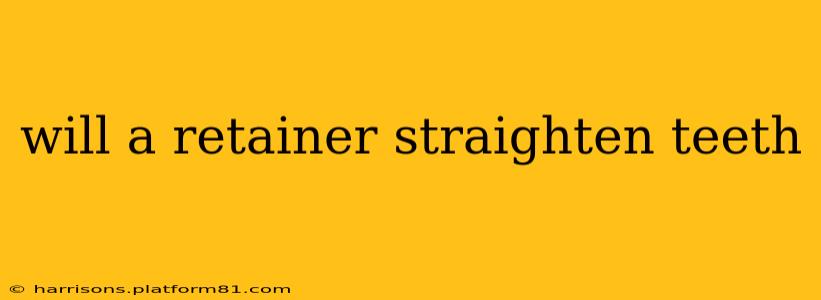Will a Retainer Straighten Teeth? Understanding Retainers and Teeth Straightening
Retainers are essential for maintaining the results of orthodontic treatment, such as braces or Invisalign. While they won't straighten crooked teeth initially, their primary role is to prevent teeth from shifting back to their original positions after active treatment has ended. This is a crucial point often misunderstood. Let's delve deeper into the nuances of retainers and their function in maintaining a straight smile.
What is the Purpose of a Retainer?
A retainer is a custom-made appliance designed to hold teeth in their newly corrected positions. They're typically worn after braces or aligners are removed. The purpose isn't to actively move teeth, but to stabilize them and prevent relapse. Without a retainer, the natural forces within your mouth can gradually cause teeth to shift back to their pre-treatment alignment. The longer you go without a retainer, the higher the likelihood of relapse.
Can a Retainer Fix Minor Shifting After Treatment?
While a retainer's primary function isn't to actively straighten teeth, it can sometimes correct minor shifts that occur after the initial orthodontic treatment. These minor shifts are often relatively small and easily corrected by the retainer's stabilizing effect. However, if significant shifting occurs, a retainer alone won't suffice, and further orthodontic intervention may be necessary.
What Happens if I Don't Wear My Retainer?
Failing to wear your retainer as instructed by your orthodontist significantly increases the risk of relapse. Your teeth may gradually shift back to their original positions, negating the results of your orthodontic treatment. The degree of relapse varies depending on individual factors, but it's generally advisable to follow your orthodontist's recommendations for retainer wear to maintain the straightness of your teeth.
Are There Different Types of Retainers?
Yes, several types of retainers exist, each with its advantages and disadvantages:
-
Fixed (Bonded) Retainers: These are cemented to the back of your teeth and are permanently attached. They offer excellent stability and are virtually impossible to lose, but they can sometimes be more challenging to clean.
-
Removable Retainers: These are usually made of clear plastic or wire and can be taken out for cleaning and eating. They're convenient but require consistent wear to be effective. Losing a removable retainer is a significant concern.
-
Hawley Retainers: These are a type of removable retainer with a metal wire that fits around the teeth and a plastic base that sits against the palate.
How Long Do I Need to Wear a Retainer?
The duration of retainer wear varies depending on individual cases and your orthodontist's recommendations. It's crucial to follow their instructions precisely. Generally, you may wear a retainer full-time initially, then transition to nighttime wear or even less frequent use as your teeth become more stable.
What If My Teeth Shift After Wearing a Retainer?
Even with diligent retainer use, minor shifts can sometimes occur. If you notice significant changes in your teeth alignment, consult your orthodontist immediately. They can assess the situation and determine the best course of action, which might involve adjustments to your existing retainer or further orthodontic treatment.
In conclusion, while a retainer won't straighten crooked teeth initially, it's a vital tool for preserving the results of orthodontic treatment. Consistent retainer wear significantly reduces the chance of relapse and helps maintain a beautiful, straight smile. Always consult with your orthodontist for personalized guidance on retainer use and maintenance.
